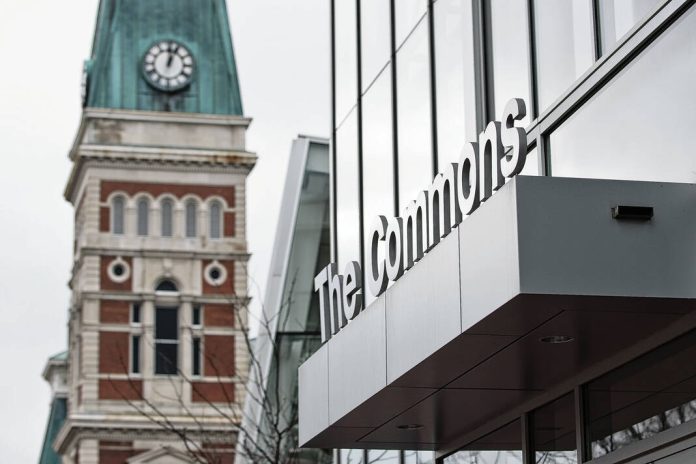Regional planning officials and regulators are taking initial steps towards studying the viability and potential development of passenger rail service between Louisville and Chicago — including the potential for a stop in Columbus.
The Kentuckiana Regional Planning and Development Agency is in the process of finalizing an agreement with the Federal Railroad Administration on the terms of a $500,000 grant awarded in December to look at potential passenger rail service between Louisville and Indianapolis.
The Louisville-based planning agency hopes to hire a consultant this spring who would guide officials through the first step of what will likely be a “multi-year effort” to determine the feasibility of passenger rail between the two cities, said Andy Rush, the agency’s director of transportation.
At the same time, the Indiana Department of Transportation has been awarded a similar $500,000 grant from the Federal Railroad Administration to look at passenger rail between Indianapolis and Chicago, said INDOT spokeswoman Cassie Bajek. Should both segments come to fruition, they would complete a roughly 300-mile route between Louisville and Chicago.
The grants seek to bankroll efforts to develop the scope, schedule and cost estimate to complete a service development plan between the cities, Rush said. The service development plan would include, among other things, market conditions, potential frequency and speed of trains, cost of investment, ridership estimates, cost of improvements to existing railroad infrastructure and the location of potential stops.
Multiple locations for potential stops between Louisville and Indianapolis are expected to be evaluated during the planning process, but “probably at the top of the list would be Columbus,” Rush said.
“Frankly, there’s not likely to be lots of stops between Louisville and Indianapolis. That would be inefficient,” he said. “But Columbus is a pretty prime location. It’s more or less central, and it’s the largest city between here and there.”
The grant funding comes from the Federal Railroad Administration’s Corridor Identification and Development, or Corridor ID, Program, which was created through the Bipartisan Infrastructure Law to facilitate the development of intercity passenger rail corridors, officials said.
The law, passed in 2021, earmarked $66 billion for passenger and freight rail improvements, including “the funding of studies around the country for more Amtrak or passenger rail service,” said Amtrak spokesman Marc Magliari.
Cummins Inc., the largest employer in Bartholomew County., was a vocal supporter of the legislation. Then-Cummins President and COO Jennifer Rumsey was among a group of business and political leaders who joined President Joe Biden on the White House lawn as he signed the $1 trillion bill into law.
However, the entire congressional delegation representing Columbus — Rep. Greg Pence and Sens. Todd Young and Mike Braun — voted against the bill that may end up funding passenger rail in Columbus, federal records show.
Proposed route
The grant funding comes a couple years after Amtrak proposed a new passenger rail line that would connect Louisville to Chicago, with a stop in Columbus along the way.
The proposed route, part of Amtrak’s plans to expand passenger rail service nationwide, would pass underneath the railroad overpass at the intersection of State Road 46 and State Road 11 on Columbus’ west side and potentially includes stops in downtown Indianapolis and the Indianapolis International Airport, according to a proposal posted on Amtrak’s website.
As originally proposed, there would be four roundtrips daily from Louisville to Chicago, meaning that passenger trains would pas through Columbus eight times per day — four times in each direction.
Passengers boarding a northbound train in Columbus would stop in downtown Indianapolis, followed by the Indianapolis International Airport, Crawfordsville, Lafayette, Rensselaer, Dyer and downtown Chicago. Passengers heading south from Columbus would stop in Jeffersonville and Louisville, according to the original proposal.
Currently, it is unclear how long it would take to travel from Columbus to Indianapolis, Louisville or Chicago by train should the proposed route come to fruition. Amtrak previously estimated that it would take about 5 hours, 45 minutes to travel from Louisville to Chicago and 3 hours, 35 minutes from Indianapolis to Chicago.
Rush said it is too soon to know how fast the trains would be able to go but said the regional planning agency is hoping for “car-competitive” speeds, meaning “what if the train went just as fast as we could in our car on I-65?”
Right now, the speed limit on the Louisville & Indiana Railroad tracks, which run under the railroad overpass on Columbus’ west side, is 49 miles per hour, considerably slower than interstate speed limits.
“There are upgrades on many different levels that would have to be made (to accommodate passenger rail), and it goes beyond just track infrastructure,” John Goldman, president of the Louisville & Indiana Railroad, told The Republic. “There’s technology that would have to be considered and presumably structures of some sort to get people on and off the train wherever they plan on boarding and deboarding.”
“I can’t answer for sure, but I doubt you’ll see 100-mile-per-hour trains on this line,” Goldman added.
Goldman said he received a letter from Amtrak in April 2021, “basically stating that they were looking at our line for the simple fact that at one point in time back in the early 2000s. … there was Amtrak service on it.”
Amtrak operated the Kentucky Cardinal train between Louisville and Chicago from 1999 to 2003, though it did not stop in Columbus, according to an archived version of Amtrak’s website. The only stop between Louisville and Indianapolis was in Jeffersonville.
“As far as official communication regarding Amtrak, that’s all I’ve had,” Goldman said.
Local stop?
Currently, it is unclear where a potential passenger rail station would be located in Columbus.
Whether Amtrak’s proposed route or another route ends up going through Columbus will likely depend on a number of factors, including what local communities, metropolitan planning organizations and regulators have to say about it, officials said.
City-County Planning Director Jeff Bergman said the planning department is aware of the study but has not been asked to formally participate at this point.
“The planning department is aware of the study through the Columbus Metropolitan Planning Organization,” Bergman said. “We’ll make an effort to continue to have awareness and look in on their progress. At this time, we’ve not been asked to support that study in any way or provide them with information or those types of things. At this point, we’re just going to maintain awareness and be interested in what the results are.”
In 2021, former Columbus Mayor Jim Lienhoop said one location that city officials had kicked around as a potential candidate to house a passenger rail station is the bus location near Mill Race Center.
That location would form a first-of-its-kind link between downtown Columbus and downtown Indianapolis and Louisville. Amtrak does not appear to have ever served Columbus, though some of its trains have passed through the city in the past, Magliari said previously.
A downtown station also could capitalize on the close proximity to restaurants, attractions and Cummins offices. It would also allow people to park in downtown Columbus, hop a train and be Indianapolis, Louisville, Chicago or elsewhere in a matter of hours — and even catch a flight in Indianapolis, based on Amtrak’s proposed route.
Putting in a passenger rail station presents a host of challenges, city officials said.
Former Columbus City Engineer Dave Hayward said previously one challenge is “finding a location where, when the train stops for several minutes, it doesn’t block multiple streets.”
In the meantime, officials said the possibility of passenger rail going through the city is still more of an idea at this point than a firm plan and many questions remain.
But if the route were to come to fruition and include a stop in Columbus, it’s possible that the train would be powered by Cummins, which has sold diesel engines that power Amtrak locomotives, officials said.





